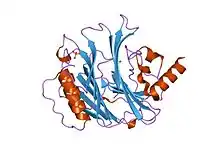Cytotoxic necrotising factor family
In molecular biology, the cytotoxic necrotising factor family of proteins includes bacterial cytotoxic necrotising factor proteins and the related dermonecrotic toxin (DNT) from Bordetella species. Cytotoxic necrotizing factor 1 (CNF1) is a toxin whose structure from Escherichia coli revealed a 4-layer alpha/beta/beta/alpha structure containing mixed beta-sheets.[1] CNF1 is expressed in strains of E. coli causing uropathogenic and neonatal meningitis. CNF1 alters host cell actin cytoskeleton and promotes bacterial invasion of the blood–brain barrier endothelial cells.[2] CNF1 belongs to a unique group of large cytotoxins that cause constitutive activation of Rho guanosine triphosphatases (GTPases), which are key regulators of the actin cytoskeleton .
| CNF1 | |||||||||
|---|---|---|---|---|---|---|---|---|---|
 crystal structure of the inactive c866s mutant of the catalytic domain of e. coli cytotoxic necrotizing factor 1 | |||||||||
| Identifiers | |||||||||
| Symbol | CNF1 | ||||||||
| Pfam | PF05785 | ||||||||
| InterPro | IPR008430 | ||||||||
| SCOP2 | 1hzg / SCOPe / SUPFAM | ||||||||
| |||||||||
Bordetella dermonecrotic toxin (DNT) stimulates the assembly of actin stress fibres and focal adhesions by deamidating or polyaminating Gln63 of the small GTPase Rho. DNT is an A-B toxin composed of an N-terminal receptor-binding (B) domain and a C-terminal enzymatically active (A) domain.[3]
References
- Buetow L, Flatau G, Chiu K, Boquet P, Ghosh P (July 2001). "Structure of the Rho-activating domain of Escherichia coli cytotoxic necrotizing factor 1". Nat. Struct. Biol. 8 (7): 584–8. doi:10.1038/89610. PMID 11427886. S2CID 19515513.
- Wang, Ming-Hsien; Kim, Kwang (2013). "Cytotoxic Necrotizing Factor 1 Contributes to Escherichia coli Meningitis". Toxins. 5 (11): 2270–2280. doi:10.3390/toxins5112270. ISSN 2072-6651. PMC 3847726. PMID 24284829.
- Matsuzawa T, Kashimoto T, Katahira J, Horiguchi Y (July 2002). "Identification of a receptor-binding domain of Bordetella dermonecrotic toxin". Infect. Immun. 70 (7): 3427–32. doi:10.1128/iai.70.7.3427-3432.2002. PMC 128056. PMID 12065482.